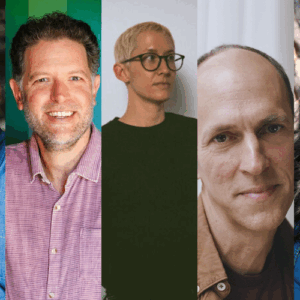
On Life and Death and the Oldest Living Thing in Pennsylvania
Barbara Hurd on the Lessons of Robert Macfarlane's Underland
It goes without saying that the California redwoods are immense. They are, in fact, the tallest living things in the world, and they do everything tall things should do; they tower, they reach, they bring to mind words like lofty, exalted. As they soar upwards into a shimmer of light and clouds, some of us might even think sublime. I certainly have, every time I’ve been among them in Muir Woods or farther north along the California coast.
But these days, I confess, such looking disappoints. It’s not that I’m tired of grandeur or that neck-craning gets harder as I age. It’s more that whatever the real questions are—what does it mean to accept our own deaths? The extinction of species? Or the end of life as we’ve known it?—I’ve come to trust I can ask them better if I’m looking in less obvious, less elevated places, searching not overhead but underfoot. Maybe that’s because, as writer Robert Macfarlane says, the below-ground world “still hides so much from us, even in our age of hyper-visibility and ultra-scrutiny. Just a few inches of soil is enough to keep startling secrets, hold astonishing cargo.”
For several weeks, Robert Macfarlane’s book Underland has kept my gaze lowered. Chapter after chapter, he has lured me to underground labs, catacombs, buried rivers, and caves. For many nights, I’ve dreamed of fungi and burrowing owls, tunnels and sinkholes. For days, my morning walks in the woods have taken on another dimension, the whole forest expanding downward and then opening into an underground immensity just as far-flung as the galaxy overhead.
I’ve kicked a lot of stones, crumbled bits of these ancient Appalachians, all of which has made me rethink a recent afternoon in Pennsylvania where, map in hand, I had driven three times up and down a curvy half-mile stretch on a backcountry road just north of Harrisburg. I was looking for a pull-off site, a “State Forest” sign, some kind of trail that would lead me to the single, foot-high bush that’s been growing in one particular spot since before the time some of those redwoods were mere seedlings—over a thousand years. For months now, I’ve been in a mood to consider mortality, including of course my own, trying to weigh the lure of longevity against the power of limits.
And then Macfarlane’s book arrived, and I began to understand the connections I had overlooked.
*
Once I found the unmarked pull-off site on the side of the road, I parked the car and stuffed cell phone and notebook in a pocket. I’d wanted to imagine I’d be on some kind of solitary quest through a tangled valley, ducking under outcroppings, checking and re-checking my map, a modern day Ponce de Leon hunting, if not a fountain, at least an example of long-life. So what that it’s not the next miracle drug I sought but a bush that’s managed to stay alive for a thousand years?
The path, short and well-marked, took me right to it. The plant is a relict, almost eliminated during the last Ice Age.
But, though there was solitude, I felt little sense of quest and no sense of achievement. The path, short and well-marked, took me right to it. The plant is a relict, almost eliminated during the last Ice Age. Somehow, a few pockets survived the brutal cold, including the patch I knelt in, which, botanists estimate, is at least 1,300 years old.
The box huckleberry—Gaylussacia brachycera, also known as the Bibleberry—looks like any number of low-growing, oval-leafed plants, like teaberry or blueberry. Botanists think the ten-acre site in Pennsylvania consists of a single strain of protoplasm spreading everywhere it can—up the base of a tree like an evergreen collar, around pine saplings, into the trail itself. Pennsylvania’s only other huckleberry colony—also a single plant—has been growing a few miles away for 10,000 years.
Few other living things continue for so long to operate under the natural world’s overarching mandate to keep spreading the DNA. Not much in my husband’s body and none in mine can comply with that directive. Nothing we do from here on out will contribute to gene pools or natural selection or to the care and feeding of the young. His sperm have grown sluggish. My egg production slogged to a standstill years ago. Evolution is not interested in us anymore.
Still, on a personal level, there are the rewards of continued good work, family warmth, the next good game, the pleasure of seeing a Motherwell painting or a black bear ambling along the edge of our field, along with making contributions to the cultures we value—art, music, literature—and to the causes that matter.
But on a purely biological level, there is on the horizon for us—and for millions of others—only the passing of time, increasing senescence, and general decrepitude—one system after another failing at ever-increasing rates. How, then, can we—do we, ought we—think about our own mortality?
In Deadeye Dick, Kurt Vonnegut writes, “If a person survives an ordinary span of sixty years or more, there is every chance that his or her life as a shapely story has ended and all that remains to be experienced is epilogue. Life is not over, but the story is.”
Epilogue, Vonnegut suggests, is shapeless afterthought, post-vital élan deadweight, the tedium of aimless dwindling.
For years, I resisted this grim pronouncement and all that it suggests of the end of the line and finalities. Though I don’t believe in any heavenly life after death, I’ve wanted to imagine ways our lives persist, to recognize, for example, that our story is always being absorbed into a different story. That its previous shapeliness might be on its way to a different shape. Or that it has dipped below ground to become part of the soil from which emerges whatever’s next.
The underland, Macfarlane warns, is “terrain with which we daily reckon and by which we are daily shaped.”
But does such thinking, I wonder, serve mostly to soften the final blow and allow us to side-step that most un-western notion of the value of limits? When the poet William Blake declared, “The road of excess leads to the palace of wisdom,” I suspect he could not have imagined the excess to which some might go for something close to everlasting life. In California’s Silicon Valley, numerous biotech companies spending billions of dollars to reverse the aging process are aiming for human lifespans of 120, 150, 170 years. One executive decries this society’s “pro-aging trance” and claims we can push for 1,000. In western countries you can pay $80,000 to have a surgeon sever your dead head and freeze it, in hopes that geneticists will use your DNA to grow a spanking new body so you can have it reattached and carry on another hundred years.
Wisdom? Even Blake might have reminded us of the lesser-known second half of his famous quote: “For we never know what is enough until we know what is more than enough.” Somewhere between too much and too little is where we learn sufficiency and how limits help us to distill and refine, to concentrate and shape. But these are rational thoughts, which seldom matter when death or extinction is imminent, when the longing to go on and on stirs and thrums in the about-to-be-buried body. The underland, Macfarlane warns, is “terrain with which we daily reckon and by which we are daily shaped.” It is the realm from which both limitless sorrow and hunger swirl.
*
My husband has Parkinson’s disease. He’s a poet whose days are still full of work and play. He writes and reads, back-hand slams a ping-pong ball past his opponent’s astonished face, makes love, listens to music, visits with old friends. Parkinson’s is incurable and degenerative; his movements are often halted by episodes of freezing. Some days he can’t open a bottle of wine. There will likely come a time when he has trouble swallowing, when he can no longer walk at all, and we will be faced with questions of feeding tubes and assisted living. Below those looming dilemmas lies a central question: how far will we go? For the sake of living longer, how far will we venture into the world of more drugs, new clinical trials, extended physical therapies along with likely incontinence, wheelchairs, and bed lifts? If there’s a choice, it will, of course, be his, not mine. Sometimes we talk about this. Sometimes I go for walks in the woods.
*
With age, supposedly, comes wisdom and here’s the paradox: the ethical question we should be ready to ask in old age might jeopardize our chances of living to an even older age, that is, just because we’re a wealthy country that can pour billions of dollars into research that might assure that our failing bodies won’t fail just yet, should we? I’m not talking here about preventing or curing diseases that shorten the lives of the young or ways of improving the general health of a population or about anything we can do to ease someone’s suffering. What I worry about is the mindless goal of doing whatever it takes so that we, the mostly privileged, can push longevity into our eighties and nineties, even hundreds. I suspect many of us in western societies live as if our futures were, Vonnegut be damned, shapeable.
I worry, too, about how medical funds are distributed. I don’t know if spending billions of dollars for research into artificial knees means spending billions less for malaria or polio vaccines, AIDS drugs or cleaner water. And I don’t know how to calculate other costs of longer lives: more assisted living facilities, more Medicaid and Medicare, more people around for more and more decades consuming more and more in a world with increasingly limited resources.
All of us chafe against limits that incarcerate, especially ones imposed by others. But maybe mortality is a limit that can work the way all good limits can. The work of the artist—and all the rest of us—is, finally, about creating within frames, boundaries, restraints. We can rail against death, pour money into cryonics or colonies on Mars, or we can feel mortality as a container that might help us fashion wiser, more tempered, more exquisitely formed responses to one another, to our homes, and to this planet.
How to balance those questions when I’m the one watching my husband try to get from the kitchen to his study with a cup of coffee in his shaky hand? Of course we opted for the complicated procedure known as deep brain stimulation. Medicare paid something close to $90,000 for it, and for now that coffee stays mostly in the cup.
*
It turns out that the story of Ponce de Leon’s search for a Fountain of Youth was pure fabrication. The truth is that a historian named Gonzalo Fernández de Oviedo y Valdés wished only to discredit Ponce, and so reported to the Spanish court that the gullible explorer was off in the New World following cockamamie directions of some jokester Native Americans toward a fountain everyone knew did not exist. Ponce, in fact, did no such thing, dying instead at age 47 from an arrow wound in Cuba. But the fountain story was a good one and even though people knew even then that such a quest was silly, designed only to make Ponce looks foolish, it’s the story that’s persisted and become another historical lie. Such is our romance with eternal youth and with heroes who reject Vonnegut’s claim that Life is not over, but the story is.
In the meantime, my husband contemplates a future suicide, the possibility of a decision against prolonging the kind of life he doesn’t want. It’d be sensible, he says, meaning he’s thinking, as Vonnegut does, of his story and an ending he’d like to write himself. That’s his kind of frame. Neither of us knows what that might mean.
*
A redwood survives by thickening its bark and upping its production of tannic acid. The bark insulates from fire; the acid protects from rot. Both mean a tree can survive in big display in the open air, 350 feet tall, taking up some 38,000 cubic feet of above-ground vertical space.
The box huckleberry does the opposite, and it can live far longer. It survives by insulating most of its actively growing parts safely underground. For someone like me, whose imagination is so enlivened by subterranean spaces that I wrote a whole book on caves, this seems like a good plan. Keep the tender sprouts out of sight, nestled in damp and protected places. The huckleberry’s plan—can we even call it a plan?—for growth is, of course, more literal. Some time way back in its evolutionary past, the original stem turned sideways and burrowed down. For hundreds of years, that same buried stem has been pushing horizontally in all directions, branching and re-branching below the surface. It reproduces by cloning, meaning it grows by extending its very same self on and on and on. It doesn’t evolve; it doesn’t change. In some ways, it’s an example of stasis without end, not the kind of life my husband—or I or most people I know—would choose.
Am I suggesting here that Vonnegut might be right? That longevity dooms one to living long after the story really ends?
Reading Macfarlane complicates that notion. His book, in fact, sent me back to that hillside and plunked me down on the dirt where questions of limits vs. longevity dissolve into images of communal intimacies. I knelt in the center of a low-growing plant that had been there for eons and pushed my fingers into the ground, feeling around for anything resembling a single stem or rhizome. There was none. Even the gentlest prying-up revealed a snarled mat of fibers and soil. Dirt got under my nails. As I brushed hair from my eyes, small clods smeared my forehead. Though a plant has no idea what it means to live a singular, storied life, the huckleberry reminds me there’s more than one way to be vital. Below the surface, there was no untangling, no separating. No end to intertwining and connections, the intricacies of a living colony. The realization nudged me to try to broaden my definition of “alive.”
In spite of its emphasis on deep time and long perspectives, Underland is ultimately about “Nature . . . as an assemblage of entanglements of which we are messily part.” It’s about familiarities and closeness and immersions, about going down into, feeling the earth, the cave, tunnel, catacombs rub up against your skin. As the book makes clear, the stories of deep time cannot help but arrive slimed with mud, drenched with seawater, or coated with sand. They come from below-ground places in the earth; they carry bits of the planet’s grit. To get at those secrets, that intimacy, you have to get a little dirty. You have to get down to the layer where things are buried.
*
If my beloved dies before I do, any deep-time perspective I might have will likely implode for a while and I will, like most mourners, be left with the gone sweet grubbiness of two lives twined together for so long, the intimacy of sorrow, and the effort it takes to make it through another day.
I can hope that grief will ease later and I might recall the bigger picture. To remember the long history of the world, its changes big and small, is to be reminded that no matter how well or ill-shaped or how limited or how over our own stories are, they are always—I still want to maintain—embedded in larger ones. We do this and that today. We get the job, find a lost friend, accomplish whatever. The coffee spills or it doesn’t. Meanwhile, continents still drift, mountains wear down while others rise. I might be talking about grandchildren here as well as the enduring power of art, waters from uplifted mountains, seeds careening across glacier-scarred landscapes, huckleberry bushes that have survived since way before Jesus promised everlasting life.
Perhaps our story as a species is almost done and all that remains is an unwanted intimacy with grief.
How to think about the end of all of that? About the mortality of our entire species, the million other species now heading toward extinction, the habitats, communities, whole biomes? Does Vonnegut’s claim apply here too: just enough story, not too much epilogue?
In our hubris, we’ve exceeded our limits, sullied the waters and filled the atmosphere with gasses now choking our planet. “We stand,” Macfarlane says, “with our toes, as well as our heels, on a brink.”
Perhaps our story as a species is almost done and all that remains is an unwanted intimacy with grief on a scale no private loss can prepare us for. In our disregard for limits, we’ve sacrificed, it seems, the ability to control what happens next and what legacies we’ll leave. We can’t shape the human story any longer. And so perhaps the Anthropocene is, in fact, all epilogue now, and our obligation is to stay with the trouble we’ve caused, see it out to its dwindling end.
Or maybe our obligation is to devise a different kind of epilogue. The notion of story or a life as linear is, in itself, a limitation, the type to disregard. What if we saw epilogue as a web of sprawling mutualities spreading everywhere it can, radially-shaped, even kaleidoscopic, branching and re-branching below the surface, underlandish entanglements of mud and green and sea and of the human and more-than-human worlds in which we, chorus-like, lose and find ourselves again and again.
Not the deadweight of aftermath but hints that a new story is already underway—how to live with grief, how to provide hospice for whole species.
The quiet suggestion of some kind of sequel.
The underlands, Macfarlane says, remind us that what will outlast our species is not love but radioactive waste and plastic. But then he offers us the image of an open hand that he’s threaded throughout his book and the scene with which he ends: he and his son are out in the woods; he’s kneeling on the ground as the boy raises his hand. I reach, Macfarlane writes, my hand towards his and meet it palm to palm, finger to finger, his skin strange as stone against mine.
A gesture at the intersection of intimacy and abyss, which is, finally and urgently, where we have the most to learn.
Barbara Hurd
Barbara Hurd is the author of Listening to the Savage / River Notes and Half-Heard Melodies (2016), Tidal Rhythms (with photographer Stephen Strom, 2016), Stepping into the Same River Twice (with artist Patricia Hilton, 2013), Walking the Wrack Line (2008), Entering the Stone, a Library Journal Best Natural History Book of the Year (2003), The Singer's Temple (2003), Stirring the Mud, a Los Angeles Times Best Book of 2001 (2001), and Objects in this Mirror (1994). Her work has appeared in numerous journals including Bellingham Review, Prairie Schooner, Best American Essays, The Yale Review, The Georgia Review, Orion, Audubon, and others. The recipient of a 2015 Guggenheim Fellowship, an NEA Fellowship for Creative Nonfiction, winner of the Sierra Club’s National Nature Writing Award, four Pushcart Prizes, and five Maryland State Arts Council Awards, she teaches in the MFA in Writing Program at the Vermont College of Fine Arts.












